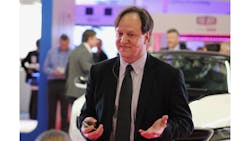Father of LED Li-Fi surfaces at Kyocera SLD for laser Li-Fi
One of the more promising sectors for the long-gestating market for Li-Fi is aerospace. Use Li-Fi instead of Wi-Fi to deliver Internet on a commercial plane, and you can avoid radio interference and other issues that can undermine inflight Wi-Fi.
So it made sense a few weeks back when laser chip innovators Kyocera SLD Laser announced they teamed up with Seattle-based aerospace data networking specialist Spectrum Networks LLC to help develop onboard Li-Fi systems.
The pairing has as much potential as there is in the Li-Fi world. Lasers, rather than the LEDs that so far have underpinned Li-Fi systems, could well be the technology that finally ushers in something resembling widespread Li-Fi adoption. Kyocera SLD has pedigree; last year, Japan’s Kyocera acquired SLD, the Santa Barbara company founded by Nobel-winning LED scientist turned laser enthusiast Shuji Nakamura. Spectrum appears to be a solid, light-focused group founded over a decade ago by aerospace veterans. Commercial airlines and others have shown interest in Li-Fi.
But what stood out just as much in the announcement was another prominent name — Harald Haas, whom Kyocera SLD and Spectrum described in a joint press release as having “direct involvement” in the project in his capacity as a “KSLD Senior Advisor.”
Setting aside for a moment that Haas could well give valuable guidance (he is regarded by many as the father of Li-Fi), the knee-jerk reaction here is: WHAT?! That’s because Haas, as many readers will know, is the co-founder and chief scientific officer of pureLiFi, the Edinburgh, Scotland-based pioneering Li-Fi company.
pureLiFi is arguably the best known of all Li-Fi outfits (sorry, Signify, but you’re best known for plenty of other things), and Haas is indisputably the face of the company. He has been giving globetrotting demonstrations of pureLiFi-connected LED lights pretty much since as long as there has been a pureLiFi.
So what he is doing getting so involved with a group that could be construed as a competitor to pureLiFi?
LEDs Magazine posed that question to both KSLD and pureLiFi. We had not heard back by the time this story posted.
But we do know that Haas is a big proponent of laser-based Li-Fi. Like others in the business, he believes that lasers, with speeds and distances roughly 100 times greater than LEDs, could provide the wallop that the technology needs for wider adoption as a data networking medium.
Two years ago, he told this writer that, compared to LEDs, lasers “can go an order of magnitude faster.” At the time, pureLiFi LED systems were operating experimentally at about 1 Gbit/s (slower in the real world), but Haas enthused that, with lasers, “I see a clear path to 100 gigabit per second in the next year or two, and we are looking at one terabit per second in the next five years.”
Haas, who is also a professor and mobile communications chair at the University of Edinburgh, was in that capacity part of a five-year multi-university project called the Terabit Bidirectional Multi User Optical Wireless System for 6G (TOWS), which with £8 million in UK government funding was hoping to hit a terabit per second by 2024. Leeds University was leading TOWS, which also included the University of Cambridge.
Haas has long straddled the worlds of academia and industry. In his role as professor, for example, he is part of a team from different institutions examining a technique called RIS that could lessen the need for Li-Fi to have direct line of sight and thus expand the technology’s reach.
Whether he is donning his professor’s cap at Kyocera SLD or whether he is there as partner on behalf of pureLiFi, or perhaps as an industrial partner in a different cloth, is something we hope to learn more about. Either way, we wonder whether pureLiFi itself is pursuing the laser route.
LED-based Li-Fi has progressed slowly in the commercial market, held back in part by the failure so far of computer and gadget makers to embed Li-Fi receivers, something that Signify CEO Eric Rondolat has acknowledged. In one exception, Taiwanese ruggedized laptop maker Getac is embedding pureLiFi product.
MARK HALPER is a contributing editor for LEDs Magazine, and an energy, technology, and business journalist ([email protected]).
For up-to-the-minute LED and SSL updates, why not follow us on Twitter? You’ll find curated content and commentary, as well as information on industry events, webcasts, and surveys on our LinkedIn Company Page and our Facebook page.

Mark Halper | Contributing Editor, LEDs Magazine, and Business/Energy/Technology Journalist
Mark Halper is a freelance business, technology, and science journalist who covers everything from media moguls to subatomic particles. Halper has written from locations around the world for TIME Magazine, Fortune, Forbes, the New York Times, the Financial Times, the Guardian, CBS, Wired, and many others. A US citizen living in Britain, he cut his journalism teeth cutting and pasting copy for an English-language daily newspaper in Mexico City. Halper has a BA in history from Cornell University.





